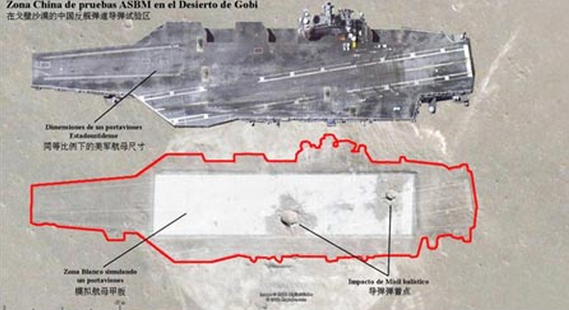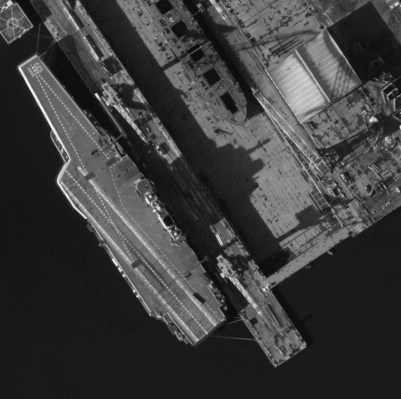China's first aircraft carrier, the Liaoning, in the port of Dalian.
The Chinese navy is building a second aircraft carrier, raising the stakes for the U.S. Navy—and China’s nervous neighbors—in the western Pacific.
The South China Morning Post reported Sunday that construction of the follow-on flattop has begun in the port city of Dalian, and estimated it would be finished by 2018. It would be Beijing’s first carrier built from the keel up in China. The People’s Liberation Army Navy wants a flotilla of four carriers by 2020. The English language paper, based in Hong Kong, cited Chinese online news reports for the news. Those reports were subsequently deleted, it added.
The push to build carriers—the bluest of ships in a so-called blue-water fleet, designed to operate in mid-ocean—comes as China is expanding its territorial reach off its coast and developing the weapons needed to make such claims stick.
It’s still a long way from approaching the size of the U.S. Navy, which has 10 Nimitz-class carriers and is building two new Ford-class vessels. At nearly 1,100 feet, each of these classes of carriers are about 100 feet longer than China’s lone Liaoning vessel, which it bought, used, from Ukraine in 1998. The U.S. Marine Corps also has nine 840ft amphibious-assault ships, which the Navy describes as resembling “small aircraft carriers.” Two more are under construction. No other nation has more than two carriers.
China asserts its weapons are defensive in nature, designed only to keep foreigners at bay. The only foreign navy able to counter an expansionist China is the U.S. Navy, which under President Obama is shifting its focus, and might, to the Pacific.
But not everyone thinks that “pivot” is sufficient. “It’s clear that Chinese leaders are ambitious and that their diplomatic policy and the military arm are moving them toward great power status or at least regional hegemony, in a series of small steps designed to achieve these ends with minimal resistance from their Pacific competitors, America’s allies,” former senior Pentagon official Seth Cropsey, now with the Hudson Institute, told a congressional panel last month. “The U.S. is not taking this possibility as seriously as it should.”
China’s military spending has tripled over the past decade, and is now roughly a third of what the U.S. military spends, Jim Thomas of the independent Center for Strategic and Budgetary Assessments (CSBA) recently told Congress. “Unlike the United States, however, with its competing global security responsibilities, China is able to focus its resources almost entirely on supporting its regional counter intervention strategy,” Thomas said. Its goal: “To conduct short, decisive campaigns before an outside party like the United States could intervene effectively.”
The Chinese strategy is twin-pronged. First, a fleet of aircraft carriers is a mark of a major military power and gives its owner the ability to attack targets far from the homeland. But building such ships is complicated, and operating them is even more so. It helps to think of carriers as being like nuclear weapons—as daunting as they are to build, deploying and using them in a militarily significant way is even more challenging.
“Carrier ops are about as complicated an operation as any we conduct,” Army General Martin Dempsey, chairman of the Joint Chiefs of Staff, said last month. “[The Chinese] are a long way from being a threat to us with their aircraft carrier.”
That’s why the second prong of China’s strategy is vital. Instead of only challenging U.S. carriers on the high seas with similar warships, it’s developing land-based DF-21D missiles with maneuverable warheads, designed to reach out and kill U.S. carriers from at least 930 miles away.

This Google Earth photo, with a carrier outline superimposed above, purportedly shows a pair of successful Chinese DF-21D missile hits on a carrier-sized target in China’s Gobi Desert last year.
In 1996, the U.S. Navy dispatched a pair of carriers to the waters off Taiwan after Beijing threatened the island nation, which it regards as a renegade province, by launching missiles in its direction. Development of the DF-21D is intended to make the U.S. think twice before doing that again.
Last year, China conducted a test of the DF-21D in the Gobi Desert. While its accuracy is questionable, “large salvo attacks” could make up for that, CSBA’s Thomas says: “China might be willing to expend hundreds of anti-ship ballistic missiles, with an estimated unit cost of $25 million,” he says, “in a saturation attack to destroy or `mission kill’ a single aircraft carrier, valued $10-15 billion.”
Pentagon officials, speaking privately, are more concerned with the new missiles than the new warships. In fact, Dempsey—the top U.S. military officer—has an even bigger concern when it comes to Beijing. “I worry more about a China that falters economically,” he said last fall, “than I do about them building another aircraft carrier, to tell you the truth.”


